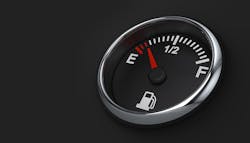Fuel economy regulations for MY 2021-2026 cars, light trucks reduced by 30%
The final Safer Affordable Fuel-Efficient (SAFE) Vehicles Rule to lower greenhouse gases has been set for model years 2021-2026 passenger cars and light trucks, reducing the incremental improvement of (Corporate Average Fuel Economy) CAFE and CO2 emissions standards from 5% down to 1.5% per year. The cumulative result will be a 40.4 mpg standard for MY 2026 vehicles as opposed to 46.7 mpg.
The decision was made by the U.S. Department of Transportation's National Highway Traffic Safety Administration (NHTSA) and the U.S. Environmental Protection Agency (EPA) to introduce “tough but feasible fuel economy and carbon dioxide standards” while making vehicles safer and affordable.
EPA Administrator Andrew Wheeler said the new rule “strikes the right regulatory balance that protects our environment, and sets reasonable targets for the auto industry.”
The thought is that OEMs will spend less on research and development rushing to meet strict fuel goals, and that savings is passed on to the customer who will pay $1,000 for a new pickup truck, for example. The NHTSA estimated the “more affordable” price tags will lead to 2.7 million more vehicles sold through 2029, which, by and large, will have more efficient engines due to existing Clean Air Act standards.
According to the NHTSA, the more accessible new cars will also have better safety features than older models. The agency projects the new cars will lead to 3,300 fewer crash fatalities, 397,000 fewer injuries, and more than 1.8 million fewer vehicles damaged in crashes.
"This rule reflects the department's No. 1 priority—safety—by making newer, safer, cleaner vehicles more accessible for Americans who are, on average, driving 12-year-old cars,” said U.S. Secretary of Transportation Elaine L. Chao.
President Trump, who established an anti-regulatory position during his election campaign and has not wavered, tweeted the following:
Both agencies credited Trump for course-correcting the 2012 standards set during President Barack Obama’s tenure, which Chao called “costly” and “increasingly unachievable.” These new standards, by contrast, will “reinvigorate American auto manufacturing” just as the president promised autoworkers three years ago, she added.
Obama lambasted the decision in his own tweet:
NHTSA reevaluated the stricter milestones due to a federal mandate to maintain a “maximum feasible level” of CAFÉ standards. This is based on four factors:
- Technological feasibility
- Economic practicability
- Effect of other motor vehicle standards of the government on fuel economy
- U.S. need to conserve energy
In 2018, the EPA issued the Mid-Term Evaluation Final Determination, analyzed the current engine and fuel technologies available, evaluated more than 750,000 public comments and held three public meetings.
The overall impact of easing the standards amounts to a “$200 billion reduction in total costs over the lifetimes of vehicles through MY 2029” and “$100 billion reduction in regulatory costs,” NHTSA concluded.
The 2012 model also was set while the average national fuel cost was $3.60/gal., as opposed to the current $2.00/gal. The 46.7 mpg end target would have saved drivers $220 per year over the approved 40.4 mpg goal for 2026, though at current prices it is $100/year.
Environmental cost
The automotive industry is poised to benefit in less regulations and more sales, but environmental advocates say it’s at the cost of the planet’s health. The new rule adds about 1 billion additional tons of CO2 per vehicle throughout its lifetime over the 2012 standards.
This will have costly effects people won’t feel at the pump, but could experience in their bodies.
“While the rest of the world moves toward cleaner and more efficient transportation standards, the Trump administration is dragging its citizens backward, costing us more in fuel and in pollution that causes climate change and health harms from asthma to heart attacks,” said Danielle Fugere, president of As You Sow, a nonprofit that promotes sustainable solutions and corporate responsibility.
The new rule “is sure to be challenged in the courts, adding unnecessary uncertainty to an industry under transition at a time of immense economic disruption,” added Fugere, former executive director of the Environmental Law Foundation.
Lowering the bar will have an adverse effect on the auto industry’s future, she argued: “The new rule will stifle innovation and leave the U.S. auto industry stagnating and lagging behind international automakers. The administration has overreached beyond what is in the best interest of industry and is impeding American-led innovation.”
The Auto Big Three have already invested a sizable amount into electric vehicles, which produce zero emissions, indicating they are operating responsibly independent of government regulations. Fiat-Chrysler Automobiles planned at least $9 billion, Ford has dedicated $11.5 billion, and General Motors plans on spending $20 billion through 2025 on electric and autonomous vehicles.
“We are aggressively going after every aspect of the EV ecosystem because we need millions of EVs on the roads to make a meaningful impact toward building a zero-emission world,” said GM CEO Mary Barra in early March.
About the Author
John Hitch
Editor
John Hitch is the editor-in-chief of Fleet Maintenance, providing maintenance management and technicians with the the latest information on the tools and strategies to keep their fleets' commercial vehicles moving. He is based out of Cleveland, Ohio, and was previously senior editor for FleetOwner. He previously wrote about manufacturing and advanced technology for IndustryWeek and New Equipment Digest.

